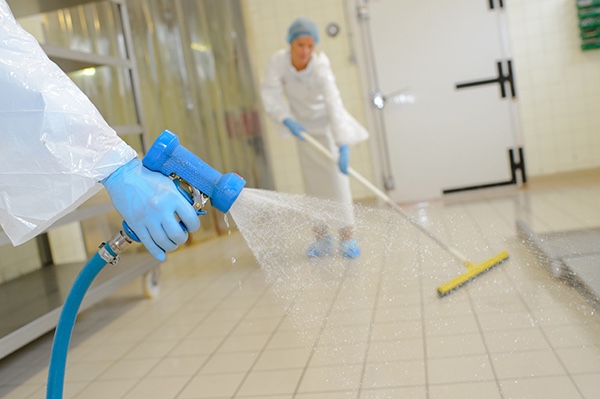Why Is Effective Cleaning and Sanitizing So Important?
Effective cleaning and sanitizing helps protect the health of the animals by controlling the transmission of animal diseases. It controls human health by preventing transmission of human diseases in foods. Cleaning and sanitizing helps prevent pest infestations by reducing residues that can attract and support pests. It also improves the shelf life and sensory quality of food products.
Effective Cleaning and Sanitizing
Effective cleaning and sanitizing is done by identifying areas and items to be cleaned. Then, effective chemicals and application methods must be selected. Clean is competed first, then sanitizing is done in 2 steps. You should perform CandS regularly, and validate that the program has been performed correctly.
What Should be Cleaned and Sanitized?
All surfaces that may contact the food product, such as utensils, knives, tables, cutting boards, conveyor belts, ice makers, ice storage bins, hands, gloves, and aprons. Surfaces that do not directly contact the product such as walls, ceilings, floors and drains have a profound effect on environment.
What Else Should be Cleaned and Sanitized?
Cleaning tools like brooms, mops, squeegees, buckets, sponges, scrapers, foaming equipment, water guns, etc., should be cleaned and sanitized. Cleaning tools can be a major source of microbial contamination if not cleaned. Cleaning tools should be washed and sanitized after every use. They should be stored clean, dried, and secured.
The Cleaning Step
Cleaning is the complete removal of unwanted matter using appropriate detergent chemicals under recommended conditions. Cleaning personnel need a working understanding of the type of substances to be cleaned the basic chemistry of its removal. As we will see later, cleaning and sanitizing need to be performed in two separate steps. It is impossible to sanitize a surface that is still dirty. There must be an effective rinse after the cleaning step to remove detergent residue that can interfere with the action of chemical sanitizers.
Characteristics of Food Soils
Soil is any unwanted matter on the surface of an object that one desires to be clean. Cleanliness is an unnatural condition, because all surfaces are constantly being soiled. Special care must be taken to ensure that all soil is removed and that it is not redeposited on the substrate.
Soil may be classified as visible and invisible, the latter category being primarily microorganisms, such as bacteria, yeasts, and molds.
Soil is best identified by characteristics that give information on how it may be dissolved, because the object of cleaning is to dissolve or to suspend soil and then to wash it away.
Some food soils can be dissolved in water such as simple carbohydrates (sugars), some simple mineral salts (NaCl), and some starches. There are also food soils that dissolve in alkali, like proteins, starches associated with proteins or fats, and bacterial films (biofilms). There are food soils that dissolve in acid, like hard water hardness salts (calcium and magnesium salts), and more complex mineral films, including iron and manganese deposits. Finally, there are those that dissolve with surfactants, which include fats, oils and greases, many food residues, inert soils such as sand, clay, or fine metals, and some biofilms.
What are Biofilms?
Biofilms are a collection of microorganisms, mainly bacteria, growing together in a matrix of polymers secreted by the microorganisms. Once microbes grow into well-developed biofilms, cleaning and sanitation become much more difficult. Biofilms have a shielding effect on the bacterial cells within them, and normal cleaning and sanitizing methods may not eliminate them. Biofilms MUST be removed or prevented from forming on surfaces. Disease-producing bacteria, including Listeria, can be 1,000 times harder to eliminate if it is living in a protective biofilm. Biofilms can be very difficult to remove from surfaces, and are known to have an increased biocidal resistance due to the biofilm structure protecting the microorganisms. Biofilms can be a continual source of pathogenic and spoilage organisms if not completely removed.

Spoilage organisms such as Pseudomonas grow in biofilms and can be sloughed off during production, contaminate the food, and accelerate spoilage. The polymers secreted by the bacteria close to the surface are strong adhesives making the cells very difficult to remove. The cells in a biofilm actually take on specialized functions and can communicate with each other in a rudimentary way (called Quorum Sensing).
Water
Called the universal solvent, water is the basis for all surface cleaners. Water is a good solvent—by itself it has the ability to clean many soiled surfaces. Cleaning with water alone is the yardstick by which we measure the effect of cleaning chemicals. Other active ingredients are added to enhance the effect. Detergents aid water in removing soil.
Detergent or Cleaning Agent
Both soaps and detergents help water to emulsify fats and to suspend solid soil particles. Soaps are made from fats and lye, while detergents are synthetic chemicals. Soaps and detergents act
by reducing the surface tension of water, which increases water’s interaction with soils, surrounds and lifts the soil from the surface, and allows water to flush the surrounded soils away. Proteins will hydrate and swell when they come into contact with water, which helps alkalis to react with them, forming soluble salts.









